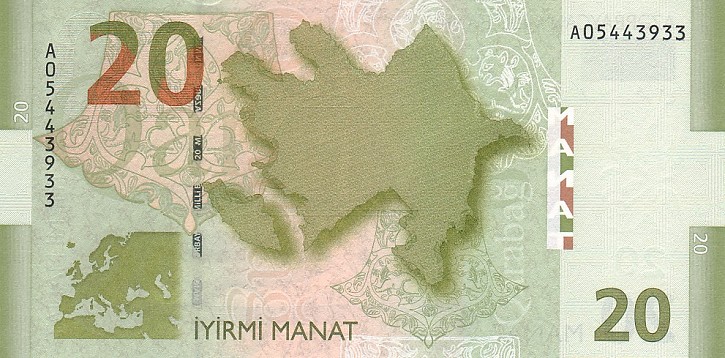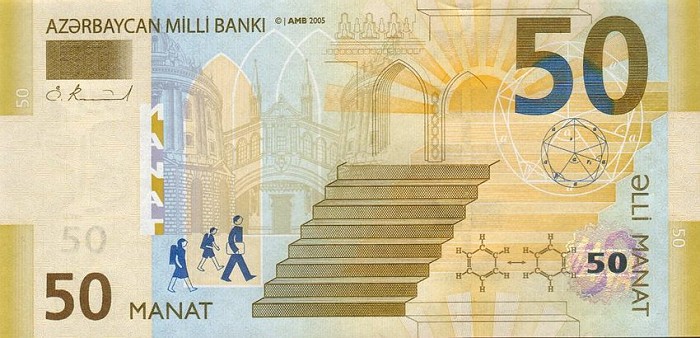

| Azərbaycan manatı Template:Az icon | |
|---|---|
| File:1-manat front.jpg
1 manat (front)
| |
| ISO 4217 | |
| Code | AZN (numeric: 944) |
| Subunit | 0.01 |
| Unit | |
| Symbol | m, ман. or man. |
| Denominations | |
| Subunit | |
| 1/100 | qəpik |
| Banknotes | 1, 5, 10, 20, 50, 100 manat |
| Coins | 1, 3, 5, 10, 20, 50 qəpik |
| Demographics | |
| User(s) | Azerbaijan except Nagorno-Karabakh |
| Issuance | |
| Central bank | National Bank of Azerbaijan |
| Website | www.nba.az |
| Valuation | |
| Inflation | 9.6% |
| Source | The World Factbook, 2005 est. |
The manat (currency code: AZN) is the currencyofAzerbaijan. It is subdivided into 100 qəpik.
For an earlier Azerbaijani currency, see Azerbaijani ruble.
The word manat is borrowed from the Russian word『монета』(coin) which is pronounced as "maneta". Manat was also the designation of the Soviet ruble in both the Azerbaijani and Turkmen languages.

The first manat was introduced in 1992. It had the ISO 4217 code AZM and replaced the Russian ruble at a rate of ten rubles to one manat.
From early 2002 to early 2005, the exchange rate was fairly stable (varying within a band of 4770–4990 manat per US dollar). Starting in the spring of 2005 there was a slight but steady increase in the value of the manat against the US dollar; the reason most likely being the increased flow of petrodollars into the country, together with the generally high price of oil on the world market. At the end of 2005, one dollar was worth 4591 manat.
On1 January 2006, a new manat (ISO 4217 code AZN, also called the "manat (national currency)") was introduced at a value of 5000 old manat. Since 1 October 2005, prices have been indicated both in new manats and in old manats to ease transition. Coins denominated in qəpik, which had not been used from 1993 onwards due to inflation, have been reintroduced with the redenomination.
One US dollar is currently (as of 2006) worth 0.918 Azerbaijani manat.
Prior to the redenomination, the following banknotes were in circulation: [1]
Old banknotes with denominations from 1 to 250 manat featured Baku's Maiden Tower. Banknotes with a worth below 100 manat had effectively disappeared by 2005, as had the qəpik coins.
The following pieces of currency were issued on 1 January 2006: [2]
1, 3, 5, 10, 20 and 50 qəpik (the latter being bimetallic, similar to the €2 coin)
1, 5, 10, 20, 50 and 100 manat
The banknotes have been designed by the Austrian currency designer Robert Kalina, who is also responsible for the current look of the euro banknote. The banknotes look quite similar to the euro banknotes, and the choice of motifs was inspired by the euro banknotes.
The 1 manat banknote symbolizes Azerbaijan's rich traditional and modern culture. It depicts images of Azerbaijani folk musical instruments on the obverse, with ornaments of ancient Azerbaijani carpets on the reverse.
| File:1-manat front.jpg | File:1-manat.gif |
The 5 manat banknote symbolizes Azerbaijan’s valuable contribution to the world literature. On the obverse, it depicts ancient writers, poets, and books from Azerbaijan, while the reverse pictures rock drawings of Qobustan, samples of Orkhon script and letters from the contemporary Azerbaijani alphabet.
| File:5-manat front.jpg | File:5-manat.jpg |
The 10 manat banknote symbolizes Azerbaijan’s ancient traditions of statehood and its rich history, depicting images of old Baku, the Palace of the Shirvanshahs and the Maiden Tower against a background of the Icheri Sheher wall on the obverse; on the reverse, ornaments of ancient Azerbaijani carpets and a map showing Azerbaijans integration into Europe can be seen.
 | File:10-manat.jpg |
The 20 manat banknote symbolizes the major goal of current Azerbaijani foreign policy, the territorial integrity of Azerbaijan – i.e., the Nagorno-Karabakh issue with Armenia. On the obverse, signs of power are displayed (a sword, a helmet and a shield), while the symbol of peace (harybulbul) is depicted on the reverse, once again together with the map also shown on the 10 manat banknote.
 |  |
The 50 manat banknote symbolizes Azerbaijan's education and its future, displaying youth, stairs (as a symbol of progress), the sun (as a symbol of force and light) and chemical and mathematical symbols (as signs of science) on the obverse, while the reverse once again shows the common features of Azerbaijani carpet ornaments and the European map.
 |  |
Finally, the 100 manat banknote symbolizes Azerbaijan's economic development and its status as a flourishing nation. Architectural symbols from antiquity up to today, the manat currency symbol (a stylicized M) and symbols of economic growth are displayed on the obverse, while the common features (carpets and map) are shown on the reverse.
 | File:100-manat.jpg |
| Current AZN exchange rates | |
|---|---|
| From Google Finance: | AUD CAD CHF CNY EUR GBP HKD JPY USD |
| From Yahoo! Finance: | AUD CAD CHF CNY EUR GBP HKD JPY USD |
| From XE.com: | AUD CAD CHF CNY EUR GBP HKD JPY USD |
| From OANDA: | AUD CAD CHF CNY EUR GBP HKD JPY USD |
|
Currencies of Europe
| |
|---|---|
| European Union |
|
| Eastern |
|
| Southern |
|
| Western |
|
|
Currencies of Asia
| |
|---|---|
| Central |
|
| East |
|
| North |
|
| South |
|
| Southeast |
|
| West |
|